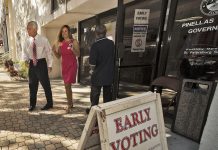Both races dragged late into the night, but Democrats fell short for Senate, Governor
One percentage point.
In the past few elections, Florida has been so close that one percentage point has separated the two closest candidates. Watching Election Night was a matter of watching that percentage point waver.
When the ballots first closed, and all that people had to go on were the mail and early voting totals, it looked like Florida would come down to, once again, one percentage point. Early on, that point favored Andrew Gillum. As precincts began to report, the lead shifted to Republican candidate Ron DeSantis.
A similar phenomenon took place in the race for US Senate between Rick Scott and Bill Nelson. Nelson had the initial lead, but quickly the one point shifted to the outgoing governor. By about 8:00, Republicans had leads in both of Florida’s most contested races.
Yet margins never got beyond that one percentage point. Candidates were separated by fewer than 100,000 votes, even as more and more precincts reported across the state.
Shortly after 9:00, attention began to focus on greater Miami, and the counties of Broward and Miami-Dade. Most of the uncounted votes late in the night were in that area, one that famously leans very much toward Democrat candidates. DeSantis and Scott both held leads, but with counties firmly shaded blue still tallying votes the question was whether either lead was quite enough.
The night dragged on, and the longer it went the more the uncounted votes appeared to concentrate in the state’s southeast. Calculators came out to tally how much of a chance the two trailing Democrats had of closing the gaps both of them were facing.
While the numbers began to look increasingly clear, that even the reliably Democratic voters of Broward, Miami-Dade, and Palm Beach Counties couldn’t make up the gap. The margins never got quite large enough for outlets to comfortably declare a winner but they also never got quite small enough for people to put Nelson or Gillum back into the leads. Nelson, the longtime politician, came closer. By the end of the night, the incumbent was nearly close enough to trigger an automatic recount, trailing by just 0.6%. Slightly over 50,000 votes separated the presumptive winner from the challenger.
Nelson held out until after midnight, conceding without a concession speech, as the crowd at his campaign headquarters had already left. The margin between Nelson and Scott became extremely narrow, nearly triggering an automatic recount, but in the end Rick Scott was the victor.
—
Strangely, the campaigns got most of the local results they wanted.
Democrats in 2018 in Florida largely focused on the state’s “swing” counties, particularly Duval and Pinellas. It is said that the candidate that carries Pinellas County generally wins the state, and the Democrats hinged much of their hopes there. They won by narrow margins in Pinellas, with both Gillum and Nelson coming out ahead in the bellweather county.
Meanwhile, the Republican candidates rallied the party base in an effort to drive turnout in those counties where the GOP had been dominant in the past. That strategy won the state for President Trump in 2016, and both DeSantis and Scott turned to counties such as Pasco to try and build their leads. They accomplished that mission, getting comparable turnout in those red counties to 2016.
That the two strategies could work and one side still inevitably lose just underlines how diverse a population in both culture and thought that Florida truly is. North Florida and the Panhandle were, with the exceptions of Tallahassee and greater Jacksonville, a solid and bright shade of red. The I-4 corridor was hotly contested, with Tampa Bay going blue and Orlando going with it, but the rest of the area pulling for Republicans. South Florida was a reliable Democratic stronghold.
A candidate can do everything they plan, and do it well, and still end up losing in Florida. The two Democrats in the major statewide races targeted Florida’s cities, and they for all intents and purposes swept those cities. The Republican Party targeted its strongholds in the state, and the Republicans in those counties did not disappoint their candidates.
In the end, the Republican strategy of energizing their base worked. There was high turnout in counties that vote predictably Republican, and likewise the Democrats were unable to produce high turnout in their own strongholds such as Broward County. The Democrats won their battleground counties, but it was their base that did not produce the votes they needed late in the night.
—
In the major statewide races, there was only one emphatic victory. Republican Ashley Moody won early over Sean Shaw in the race for Florida’s Attorney General. Moody, who cited her prosecutorial and judicial experience in her campaign for the job, took the state by a rather wide margin, winning handily on a night when the other races were down to the wire.
Moody’s victory will have her replace the outgoing Pam Bondi as the state’s “top cop” and chief prosecutor.
Outside of Moody, this was not a night for gloating, or boasting of emphatic victories. Fewer than 100,000 votes separated Senator-Elect Rick Scott from outgoing incumbent Bill Nelson. The same was true of Tallahassee Mayor Andrew Gillum’s campaign against Governor-Elect Ron DeSantis.
—
The midterm election nationally was, in boxing terms, a split-decision. Republicans picked up gains in the US Senate in Florida and Indiana, but the House of Representative wound up in the hands of the Democrats by the end of the night, including wins in Florida by Pinellas County incumbent Charlie Crist and former Democratic chairwoman Debbie Wasserman-Schultz.
Gubernatorial races were also up in the air. Florida continues its streak of Republican governors, dating back to 1994. Massachusetts incumbent Charlie Baker won handlily over a Democratic candidate in a deep-blue state.
There were no major surprises on the night. Beto O’Rourke, US Congressman and surprise challenger in Texas to former presidential candidate Ted Cruz put together a closer race than just about anybody would have expected a year ago, but O’Rourke fell short in the end. West Virginia Democrat Joe Manchin retained his seat despite his state having been one of the most emphatic in support of President Donald Trump in his 2016 campaign.
The midterm election is generally considered a referendum on the president, and in Florida, President Trump was given some good news for his 2020 prospects. The same predictable counties that rallied behind him are still energized two years later. Setbacks for the Republicans in Pinellas and Duval counties will be concerning, but at the end of the day electoral votes are measured by state, and the purple state of Florida continues to give narrow victories to Republicans in major races.
The results outside of Florida are equally mixed. The Republican party strengthens a narrow lead in the Senate, but loses the House.
—
In the end, Florida once again came down to one percentage point. Rick Scott edged Bill Nelson by a total within a point. DeSantis got past Gillum by almost exactly one percentage point.
The population of the state capital of Tallahassee is just over 180,000 people. Less than half of that total would have been enough to swing the two largest statewide elections. The population of Lakeland is larger than the margin of victory for either winning candidate. Just one percent, one hundredth of the state, is what ends up deciding elections in Florida at the end of the day.
A capacity crowd at Doak Campbell Stadium at Florida State or Ben Hill Griffin Stadium at Florida is larger than the margin of victory for either Ron DeSantis or Rick Scott.
When people say their vote does not matter, remember how thin these margins were, and how thin they always are in the Sunshine State.














